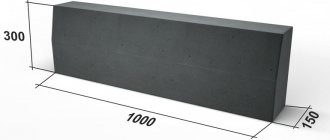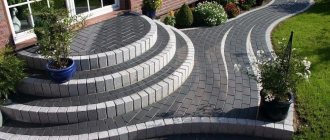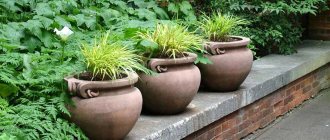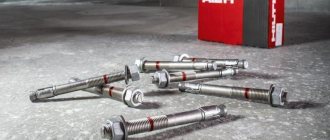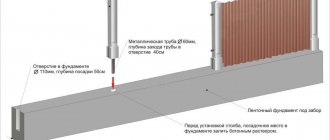A curb made of concrete mortar, side concrete stone, curb is an element of site improvement, performing the function of zoning the territory and strengthening the boundaries of sidewalks, platforms, and roads. The curb is also used for flower beds, fixing their internal content (soil, plants). Let's look at how to make borders for flower beds and paths with your own hands in this article.
Distinctive characteristics of the border
Concrete borders are both aesthetic and functional garden fencing. They differ from road curbs in their smaller height and the presence of a beveled front side. The width of these curbs is 8 cm, length - from 50 cm to 1 meter.
The advantage of borders is their wide range of applications. Concrete curbs are installed in car parks, in residential areas, and used in cottage and country house construction.
Borders well emphasize the accents of the landscape, flower beds, paths, free-standing trees and shrubs.
Curb stone has the following advantages:
- acts as a delimiter of zones of the site;
- differs in various shapes and designs;
- has strength;
- frost-resistant, has high resistance to temperature changes;
- applicable for gardening and urban improvement;
- differs in color palette and type of constituent elements;
- environmentally friendly and durable;
- easy to care for;
- decorative, resistant to mechanical stress;
- provides for replacement of elements if necessary.
Among the disadvantages is the large weight of the curb, which complicates its installation and dismantling. Due to this weight, the product is difficult to move or move if you need to change the size and shape of a flower bed, for example. Therefore, before installation, it is necessary to plan the type of structure and exact placement.
Purposes of using edge stone
Features of the use of monolithic stones determine their strength characteristics, production technology and external shape.
They are produced single-sided , when with one finishing side, which is installed to the fencing area, and the back - to the ground, and double-sided, in this case they separate single-level areas, lawns and sidewalks.
The most commonly used cross-sectional shapes for products are parallelepipeds with straight, beveled or rounded edges. A simple rectangular shape is used in road construction, while curly ones are installed in parks or vegetable garden areas.
According to production technology, curbs on an industrial scale are most often produced by vibration casting or vibration pressing.
For projects of improvement of the territories of cities and towns, vibration-pressed products are more preferable in terms of characteristics, which are easy to install, have high strength parameters and frost resistance, which increases the service life of improvement objects.
Depending on the degree of load on the structure and area of application, monolithic curbs are produced in the following modifications :
- Road - the most popular modification, used for city and highway roads, as well as intra-block and intra-house driveways, they are not limited in length, this size depends on the volume of the curb-laying machine, and in height/width they have restrictions, respectively, not lower than 30/15 cm.
- Sidewalk , very similar in shape to a road one, but has smaller dimensions in height/width - 20/8 cm. Areas of application: in residential areas, in parking lots, parking lots, in private housing construction. Such an MBB simultaneously performs both a functional and decorative role.
- Garden , similar in size to sidewalk, can also have a different size of 15/10 cm, used for designing beds, garden paths and sidewalks in the local area. One of the varieties of these modifications is a special curb for a lawn mower, which has a lowered edge below the level of the lawn, which allows you to mow along the edge of the lawn without damaging the blades.
- Landscape 15/10 cm is used for the design of a site; it can be of any shape: waves or arcs and colors.
It is prohibited to install monolithic curbs on the roadway or other places where they will obstruct the passage of vehicles and the passage of pedestrians.
Types of curb stones
According to their purpose, curbs are classified into types:
- Road curb. Installed along and near highways and sidewalks to maintain the integrity of the coating. They differ from other types in their large dimensions and high strength properties. Made from heavy concrete.
- Sidewalk curb. It has compact dimensions, is easy to install and gives pedestrian paths a finished and neat look. The curb separates pedestrian areas and prevents the destruction of paths and paths.
- Garden border. Improves garden paths, playgrounds, flower beds, trees. Provides reliability to the coating of garden paths and protects the path from dirt coming from lawns and flower beds.
Average creation costs
To determine the average cost of producing a monolithic concrete curb, it is necessary to take into account all the costs of materials and work.
The cost of the work is influenced by the qualifications of the craftsmen, the availability of high-performance machines and tools, the complexity of the form, as well as the functionality of the borders: garden from 95 rubles/running meter; road - from 180 rubles/l.m.; sidewalk - 150 rub./running meter
Initial conditions:
- Concrete for laying MBB - strength class B30 concrete M-400.
- Concrete consumption per 1 m of border measuring 20x8 cm is 0.016 m3 0.043 cubic meters. m.
Consumption of building materials per 1 m3 of M400 concrete:
- Cement M 500 – 400 kg
- Crushed stone 10 mm – 1300 kg
- Washed sand – 650 kg.
- Board for formwork 20 mm 1 m.p. — 0.01 m3
- The cost of cement M 500 – 6700 rub./t
- The cost of gravel 10 mm is 3815 rubles/t
- The cost of river sand is 650 rubles/t.
- Board for formwork - 10960 rub./m3
Cost of materials for the production of 1 m of monolithic stone:
- Cement – 0.016 m3 x 0.400 x 6700 = 42.88 rub.
- Crushed stone - 0.016 x 1.33 t x 3815 = 81.18 rub.
- Sand - 0.016 t x 0.65X650 = 6.76 rubles.
- Total: 130.82 rub./m.p.
- The cost of work for a sidewalk curb is 150 rubles/m.p.
- Total total cost: 130.82+150= 282.82 rub./m.p.
Materials for production
When creating garden border types, various materials are used, so it is easy to implement any decoration idea. They are usually selected according to the type of material and shade of the road surface. There are concrete, natural stone, ceramics, brick, wood, plastic, and metal.
One of the types is an option adapted for a lawn mower: its part on the lawn side is lowered in line with the ground, which makes it possible to start the unit on the outer side of the lawn, preventing damage to the blades during its processing.
The most popular is concrete stone, which has clear advantages. It is considered durable, can serve for a long time, and has a reasonable price. It can be purchased ready-made. Or, if desired, create it yourself using special casting molds.
In addition, borders can be created monolithic, resulting in options that have all sorts of shapes and various parameters.
The coloring elements in the solution help to achieve any shade of the product that ideally matches the shade of the path surface.
Technical properties and markings
Most often, in order to properly landscape a private area, sidewalk and garden variations are used. In factories they are mainly made by semi-dry vibropressing. Manufacturers create options with the following technical properties:
- concrete with strength index M400;
- concrete class B30;
- high resistance to frost;
- The period of operation is about twenty years.
In most situations, when arranging a site, options of 100x30x15 cm are used. If they are made in a factory, they can have dimensions of 100x20x8 and 50x20x8 cm. Options made in a factory are marked with the letters “BR” and three numbers that correspond to the parameters of the product.
Pros and cons of using
Monolithic curb stones do not differ from factory ones; if they are made in strict accordance with the Technological Map, then they will be able to show all their positive qualities in operation.
Advantages of monolithic concrete curbs:
extremely durable, their manufacture requires building materials that are available in sufficient quantities on the market;- temperature resistance to sudden temperature changes and other weather influences;
- traditionally strict appearance;
- budget cost;
- easy care and manufacturing technology;
- accessibility for self-installation.
The disadvantages of MBB include the need for trenching and formwork work.
Production methods
To improve the local area, there are two ways to create borders:
- arrangement of piece goods;
- pouring a monolithic structure of the required size and appropriate shape.
The first case involves ready-made options in the required number. A good suggestion is to create border elements with your own hands. Here you need special forms - you can purchase them or make them yourself.
This method has an undeniable advantage - the ability to repeatedly use forms, plus the simplicity of the technology for producing concrete products.
In the second case, fastening the formwork will become relevant. And this will significantly complicate the process itself. However, it is possible to create custom-shaped borders with various decorative details that serve as decoration. Which method to choose must be decided based on the intricacy of the shape of the area or paths that need to be transformed, giving them a well-groomed appearance.
What, essentially, is a curb and why is it needed?
The border borders garden paths, flower beds and other areas. Thanks to it, you can make a fenced area of a bizarre shape, and also prevent the growth of weeds, which often results in the destruction of paths. Curbs can be made of different materials; they are often used:
- concrete;
- pebbles;
- stone of natural origin;
- brick;
- ornamental plants with dense foliage.
Borders created from improvised materials turn out to be quite original. However, the most durable are those made using concrete. The main thing when manufacturing is to maintain accuracy and evenness. If the fence is located near the lawn, then it is necessary to leave a strip on the inside so that the lawn mower can pass freely. Regardless of the material used, you first need to prepare a concrete base. This is an important point for the strength of the fence. It is necessary to calculate in advance the width and height of the structure, as well as its location in such a way that you can move freely around the site and care for plants.
Materials and working tools
To create a piece border with your own hands, you will need:
- cement M400 or M500;
- crushed stone, gravel (fraction up to 40 mm);
- coarse river sand or washed sand;
- a plasticizer intended for concrete (it is permissible to use a liquid detergent instead);
- large volume of water;
- dye for concrete (if necessary).
When producing a monolithic version, to the resources mentioned above, you should add more resources for creating formwork. It is quite acceptable to make it from high-density sheet material with a smooth, even surface. You can purchase a ready-made design created at the factory. To reliably fix individual parts of the formwork, you need to stock up on pins, bars, and nails.
The structure, made of concrete, is strengthened by the use of reinforcement with a diameter of one rod of 6 mm. It is connected using a specialized knitting wire. During the work you will need the following auxiliary tools:
- concrete mixer;
- vibration unit;
- storage tank;
- forms into which concrete is poured;
- tape measure for current measurements, level;
- trowel, shovel, spatula;
- For prefabricated formwork you will need a cord, a hacksaw, and a hammer.
Tools and accessories for installation
There are two options for installing monolithic concrete stones: manually and using an extruder press machine. The set of tools that the performer will need for the job will depend on this choice. They differ from each other in that when using a press machine, a concrete mixer is not needed.
Extruders have the same type of equipment: Kohler 6.5HP Engine gasoline engine, gearbox and pusher. The machine is capable of laying 4.5 m of monolithic concrete stone 15x10 cm. For which you will need: cement-25 kg; sand -10 kg; gasoline -0.8 l per 140 m, plasticizer and dye.
Necessary materials and tools for manual production of MBB:
cement M450/500;- crushed stone up to 30 mm;
- plastic and steel reinforcement reinforcement D=6 mm;
- binding wire for steel reinforcement;
- washed coarse sand;
- plasticizer or liquid detergent;
- tap water;
- pigment dye;
- board, plywood or slate for formwork;
- fasteners and metal pins;
- concrete mixer;
- submersible construction vibrator;
- shovel;
- containers for transferring the solution;
- measuring set: plumb line, cord, tape measure and level;
- trowel and spatula;
- hammer and hacksaw.
Forms purchased and made by hand
There are various ways to create molds for producing borders. The main requirement here is the presence of a smooth surface of the resource. In this case you can use:
- steel at least 0.7 mm thick;
- waterproof plywood;
- boards.
A channel marked 16 and higher will become a convenient ready-made form. To prepare it, you need to close the ends and weld metal plates. If you don’t have a welding machine, you can simply make grooves at the ends of the channel, then insert the plates into them.
The border should have a length of no more than 2 m, then the possibility of a break is eliminated.
It is not recommended to create a border with a width that significantly exceeds the recommended one. Otherwise, it will look rough. Even when creating borders yourself, you can purchase forms or rent them.
DIY forms for borders
If the theater begins with a hanger, then the border begins with a form. It is not worth buying a matrix for casting for several reasons. Firstly, as strange as it may sound, it is solid. It is problematic to get a frozen piece of concrete out of it without damage. In factories, molds are coated with a special compound so that they do not stick. The use of oil or waste (used motor oil) does not simplify the process of removing the finished product. In addition, if the mold being poured was not level, then the oil will flow into the corner, as a result, the frozen section will have a flaw in this place.
Secondly, factory matrices have standard sizes, beyond which we cannot go. It is best to make the form for the border yourself, with your own hands. For this we need:
- a clean and even sheet of metal or thick plywood (at least 5 mm). Chipboard and QSB sheets will not work. They have a rough surface, resulting in an uneven face of the curb. And when it hardens, the solution, having grabbed the surface of the sheet, will not allow the formwork to be dismantled without damage. If you can’t find a perfectly smooth sheet and you decide to use QSB, then wrap it in thick polyethylene. It will hide surface imperfections;
- long planed bars. Be sure to be smooth, as they say, without a hitch;
- two dozen screws. It is better to take with non-hidden hats;
- screwdriver or screwdriver.
Procedure for preparing concrete
- The best option is to make the composition in a concrete mixer. Then there is a chance to get products that are as strong and high quality as possible. It is very difficult to mix concrete using a mixer, that is, manually, since it contains crushed stone, which will have a negative impact on the result of the work done and the final quality of the product.
- It is extremely important to keep the sand and water clean. For example, sand should not contain clay, which significantly reduces the grade of concrete, therefore reducing the service life of the curb itself. For this reason, the sand should be sifted first, and the easiest way is to borrow water from a well.
- To easily remove the finished product from the molds, you need to do a simple step: lubricate the inside walls well, using machine oil for this.
- Concrete mortar M400 is made from sand, cement, gravel in the ratio 1:2.5:3, and M500 - in the ratio 1:3:4.
- First, one part of the required amount of sand and crushed stone is placed, then the whole mass is mixed for two to three minutes.
- Then a portion of cement, sand, and crushed stone that remains is added. Again, all contents are mixed dry for four to five minutes.
- It is necessary to dilute the detergent in water, and then carefully add it to the dry mixture in a concrete mixer until a solution of the required thickness is obtained. If you want to have colored borders, you should add paint to the water. The concrete mixer must be constantly functioning at any stage.
- The sequence of preparing the concrete composition for both the form and the formwork is identical. There is only one difference - the volume of the solution. The greater the number of forms present, the faster the procedure for creating borders. It is recommended to have at least eight to ten forms to get a good result.
Types of stone flower beds
The simplest type can be called the usual laying of stones around a flower bed, along its entire perimeter of a regular or intricate shape. To build a flower bed, something more is required, namely, the installation of a drainage layer in the space intended for planting flowers. To do this, the soil is removed to a depth of 50-60 cm and a drainage layer of sand, gravel and crushed stone is poured down, which ensures air permeability of the soil and avoids stagnation of water in it. Then fertile soil is placed on top of the drainage layer, ready for planting.
The flower beds themselves can be made in different ways. They are:
- located level with the ground;
- raised above the ground level of the site.
A flowerbed can be made of any shape.
Arranging a flowerbed located at the same level with the ground requires minimal investment. It is enough to dig stones into the ground around its perimeter to about half their size. To create a flowerbed raised above the ground, you need to make masonry, which can be done in one of two ways:
- dry method with filling the cracks between the stones with soil;
- in conjunction with cement mortar, which is more reliable and durable.
Advice. The dry method is used mainly when creating a fairly low flowerbed border. In addition, the soil filling the voids between the stones will be overgrown with weeds, which in this case will be very difficult to weed.
Pouring into molds
When a vibrating table is used, the result is a high quality product. The forms are filled with concrete, placed on it, vibrations occur, eliminating the air space.
If there is no vibrating table, then it is quite possible to compact the solution manually: by tapping the mold with a hammer until the air comes out of it.
If there is a need for the strongest reinforced version, then you must first fill the molds halfway with concrete, then lay metal rods in them and fill them with mortar again. Its subsequent compaction is done in a similar way - through vibration.
Concrete must be kept in forms for at least 48 hours. Then remove the molds and leave the product itself for three to four weeks so that it gains strength. Only after completing this step is it permissible to begin the actual installation of curbs. You cannot rush, otherwise the product will break.
Comparison of prices for different types
In conclusion, it is recommended to consider several examples of costs for different types of borders for garden alleys:
made of concrete - from 300 rubles;- made of metal - from 300 rubles;
- made of plastic – from 250 rubles;
- made of brick - from 350 rubles;
- from natural stone – from 400 rubles;
- made of wood - from 300 rubles.
Prices for different types of boards may vary by region of the country and by manufacturer.
Installation procedure
Borders located around a flower bed or along a path always have a huge load, as they must prevent deformation, the so-called “creeping”. Therefore, a cement composition is needed. The beginning of this important procedure is the removal of the top part of the soil.
- The zone is marked, pegs are placed as clamps, and a cord is pulled along the outside at the height of the curb.
- The bottom of the dug trench is covered with crushed stone, sand, a layer of 5-8 cm is enough, everything must be compacted well.
- Then a composition of sand and cement is mixed, the proportion must be 1:4.
- The borders are placed on the mortar, then compacted using a hammer. It is necessary to control the products horizontally using a cord and a level.
At the time of final installation of a number of curb components, the structure is covered with sand on both sides and spilled thoroughly with water.
Ingredients for making concrete fencing
The stability and strength of the finished borders depends on the quality of the components. With the right proportions, long-term use can be achieved while maintaining the original characteristics and decorative properties. Components are divided into basic and additional.
The main components include the following:
- crushed stone;
- sand;
- water;
- cement.
Reinforcement is used as additional components, which gives the finished product increased strength characteristics. Decorative elements are also used to provide an unusual appearance to each concrete curb.
Monolithic border
It is much easier to install a monolithic version of the border. In addition, the process takes less time. This is because there is no need to form separate blocks. Concrete is poured immediately into the formwork on a previously prepared area. When arranging this type of border you need:
- concrete mixer;
- container in which you will need to deliver the solution to the site;
- shovel;
- hammer;
- wood boards or metal sheets;
- wooden and metal beams;
- crushed stone;
- cement;
- sand: washed or river.
Pouring concrete is carried out through the following steps:
- A special trench is being prepared; its depth should be one third of the height of the proposed curb and slightly wider. The bottom is carefully compacted and filled with crushed stone and sand.
- Along the walls of the ditch, formwork is made from a sheet resource, in the shape of a rectangle - the concrete mixture is poured here. When using beams, formwork is attached, which will prevent the occurrence of fractures on the sides of the structure. Its height must be greater than the depth of the hole, approximately at the level of the top of the curb.
- Mixing the concrete composition.
- The formwork must be filled to the very edges with mortar. To prevent the appearance of voids in the product, it is necessary to compact the solution with a metal pipe, lowering it into the solution and swinging it.
- Cover the solution in the formwork with a polyethylene film or any material that does not get wet so that the structure does not dry out quickly. Once a day, it is necessary to wet it generously with water to prevent cracks from occurring.
After the above steps, wait one week until the product completely hardens, then the formwork can be removed and the border is ready.
Why do you need to choose the right composition?
Manufacturers of building materials and professional craftsmen recommend choosing the right components for preparing a mixture for borders. You should not focus on the cost of cement, sand or gravel.
Technical parameters, fraction and purity of the feedstock are important. Only with this approach it is possible to obtain high-quality concrete curbs that will serve for a long time without the appearance of significant defects.
If the grade of cement and sand are chosen correctly, the curbs acquire important properties :
- resistance to aggressive environments and temperature fluctuations;
- resistance to severe frosts;
- creating a reliable design;
- durability properties;
- increased crystallization rate;
- protection against erosion and corrosion processes when adding reinforcement.
With the correct selection of components, compliance with the setting technology of the composition is ensured. If M400 cement is used to create the solution, setting occurs within 60 minutes. It takes about 10 hours to completely harden.
If a plastic mass is prepared from M500 cement, it will take about 45 minutes and 5 to 8 hours to completely harden. But it will take additional time to fully gain strength.
It is necessary to carefully approach not only the choice of manufacturer, but also the brand of cement . M500 has greater strength, so the use of this brand is not always relevant for creating concrete curbs.
But such designs are successful when installed in public areas, which are characterized by high traffic. If you need borders for your garden plot, you can choose M400 cement.
How to paint the border?
If there is a desire to change the color of gray concrete borders, they are painted with water-based façade paint. You can decorate a concrete surface with a water- and breathable composition, for example, based on acrylic.
Construction supermarkets stock a special paint designed for concrete stone. Cover the surface of the border with polyurethane-based paint. These dyes are resistant to abrasion and ultraviolet radiation.
You can change the color of the curb surface with a special paint - road dye intended for paving slabs. The paint can withstand any temperature changes.
Borders made of stone, brick, crushed stone
Natural stone is an excellent material for creating garden borders. When it is possible to purchase processed granite, quartzite is a great option. But you can get by with large pebbles, boulders of various sizes, sandstone or basalt.
The difficulty of arranging such curbs is the irregular shape of the stones. On the other hand, this shape gives the border individuality.
The stones are laid out both on the “dry” and on the solution. It depends on the terrain, size and shape of the curb.
A flat stone slab is laid out “dry”, and pebbles and boulders will need to be fastened with cement mortar.
Under the base of a stone fence, if it runs along a path, it is better to dig a trench and fill it with sand. The flowerbed is simply covered by pressing stones into the ground.
A modern, interesting option for making a fence for flower beds allows you to use fine crushed stone, which is poured into baskets made of metal mesh. Gabion borders have a significant advantage: they are mobile, they can be reinstalled in another location or changed in shape.
But brick is the most popular material for fencing flower beds and paths. Often the brick remains after construction in the form of broken pieces and unused remnants.
In order for a brick border to last a long time, you need to select high-quality material.
- A good solution is clinker brick. The material is not afraid of moisture and does not deteriorate for a long time.
- Facing ceramic bricks are of much better quality than ordinary bricks. The product is resistant to aggressive external influences.
- Vibration-pressed cement bricks are endowed with high strength and frost resistance.
Sand-lime brick and ordinary red brick are of little use for creating a fence for a flower bed. These materials quickly become unusable from exposure to moisture that comes from the soil.
To lay out a brick border, first dig a shallow trench. Then a leveling layer of sand is poured. There should be a distance of half a brick from the layer of sand to the surface of the soil. A mortar is placed at the bottom of the trench under each brick and laid out in the chosen position, aligning it along the stretched cord.
Regulatory acts
Manufacturers of monolithic concrete curbs are required to produce the product in strict accordance with SNiP and other basic construction and architectural requirements.
The main act that establishes the requirements for the production, installation and operation of curb stones is GOST No. 6665, published in 1991.
The monolithic concrete structure must be poured from concrete grades B30/22.5 . In certain projects, it is allowed to deviate from the standard dimensions of the stone, provided that these changes are agreed upon with the road services and the company that is responsible for landscaping the area.
Parameters and characteristics
In order for monolithic concrete side stones to meet regulatory requirements, the organization that installs such structures must have quality certificates.
To obtain them, manufactured products must periodically undergo inspection and testing for such characteristics as strength, frost resistance, crack resistance, moisture absorption and compliance of sections with GOST requirements.
Based on the test results, monolithic concrete curbs must have the following indicators :
- High strength and wear resistance. These product qualities are obtained through the use of modern technologies and grades of concrete not lower than M450.
- Frost resistance and resistance to sub-zero temperatures in cycles from F 200 to F300.
- Hygroscopicity is important for concrete products so that they maintain the integrity of the structure during the natural crystallization of water, this is achieved by adding certain additives, its class is designated W, for monolithic curbs it should correspond to 4 to 6 kg/cm 2, which allows it to withstand water pressure without absorption - 6 kg per 1 cm2 of area, the use of plasticizers allows you to increase moisture resistance by 1 step.
- The nominal period of use is over 20 years.

